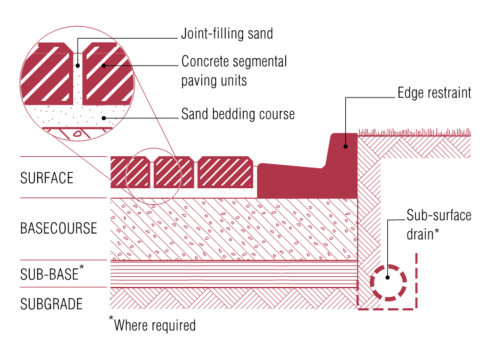Segmental and Flag Pavements
Key Considerations
- Material selection
- Subgrades
- Slip resistance
Design and Planning
- Design is to by a suitably qualified and experienced consultant (i.e.. landscape architect or civil engineer).
- Considerations should be given to:
- The type of traffic (pedestrian/vehicular/maintenance) likely to be carried
- The weight of the traffic likely to traffic the area
- The frequency or amount of traffic carried
- Abrasive characteristics of the traffic
- General layout of the pavement (surface grades/alignment)
- Drainage including, surface, sub-surface and subsoil
- Tree root control measures
- Any relevant site specific issue,
- Samples must be submitted of all proposed segmental paving materials, including the following:
- Sand: Provide certification of the grading and quality to AS 1141.11.1.
- Segmental pavers: Submit the following type test results from a NATA registered laboratory:
- Characteristic breaking load and flexural strength: To AS/NZS 4456.5.
- Dimensional deviations: To AS/NZS 4456.3.
- Abrasion resistance: To AS/NZS 4456.9.
- Salt attack resistance grade: To AS/NZS 4456.10.
- Slip resistance type test: To AS 4586 Appendix A.
- Slip resistance site test of completed paving: To AS 4663 Appendix A.
- Adhesive: Classification to AS ISO 13007.1.
Flexible Pavement
What is a Flexible Pavement?
A pavement that does not rely on a rigid layer, such as a concrete slab, to distribute superimposed loads to the subgrade.
- Base courses must be:
- Designed by an engineer
- Compacted in layers.
- Bedding course must be:
- Material that is a well-graded coarse sand.
- Compacted in accordance with the specification
- Tested as specified.
- Paved areas must be:
- Provided with perimeter edge restraints to prevent lateral spread of the pavers and consequent loss of interlock. These should be adequate to support the intended loads and to prevent the escape of bedding course material from beneath the paved surface.
- Slightly above the front edge of the edge restraint.

Rigid Pavements
What is a Rigid Pavement?
A pavement that relies on a rigid layer, such as a concrete slab, to distribute superimposed loads to the subgrade.
- Subgrades must be:
- Designed by an engineer with consideration to the following:
- Loadbearing capacity of the subgrade
- Subgrade drainage
- Base course must be:
- A concrete slab having the following properties:
- Strength to be consistent with expected traffic loading and subgrade strength
- Thickness to satisfy predicted loading.
- Reinforced to satisfy predicted loading.
- Finished slab to have falls for drainage.
- Finished to a smooth surface.
- Screeds where used must be:
- Treated to control efflorescence
- Pavers must be:
- Provided with perimeter edge restraints to prevent lateral spread of the pavers and consequent loss of interlock. These should be adequate to support the intended loads and to prevent the escape of bedding course material from beneath the paved surface.
- Control joints should be considered for the following locations.
- Over structural control joints.
- At internal corners.
- Close to external corners in large paved areas.
- Around the perimeter at abutments.
- At junctions between different substrates.
- To divide large paved areas into bays,
- At abutments with the building structural frame and over supporting walls or beams where flexing of the substrate is anticipated.
Reference Documents
Concrete Masonry Association of Australia
- CMAA PA01 Concrete segmental pavements - Detailing guide
- CMAA PA02 Concrete segmental pavements - Design guide for residential access ways and roads
- CMAA PA03 Concrete segmental pavements - Specifying guide
- CMAA PE01 Permeable interlocking concrete pavements - Design and construction guide
Clay Brick and Paver Institute
- CBPI Manual 1 Clay paving design and construction.
Document Control
Version 01, December 2020 - New section detailing the requirements for segmental and flag pavements.







